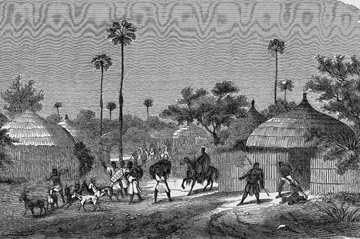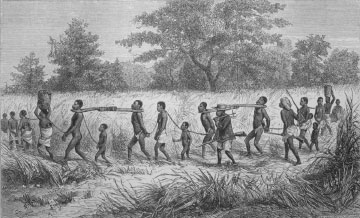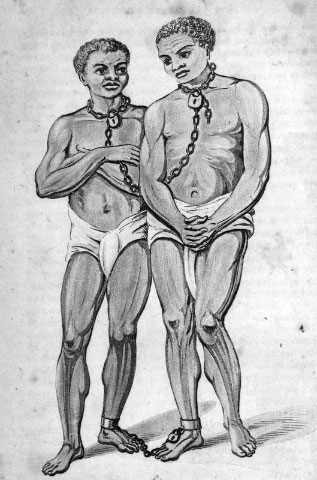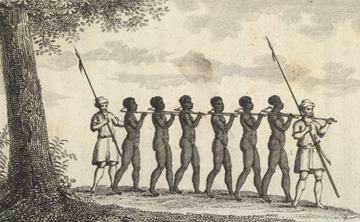Capture and Captives




For three and a half centuries, European slavers carried African captives across the Atlantic in slave ships originating from ports belonging to all major European maritime powers—Spain, Portugal, the Netherlands, Denmark, Sweden, Britain, France, and Brandenburg-Prussia. Traders from the emerging powers in the Americas also joined in the trade when possible and profitable.
European and American slavers exchanged goods for people with African traders along enormous stretches of West and Central Africa, even to Madagascar and southeastern Africa. But most Africans boarded slave ships in six distinct regions of the African coast: Upper Guinea, the Gold Coast, Bight of Benin, Bight of Biafra, West-Central Africa, and southeastern Africa. During the course of the transatlantic slave trade, nearly half of all African captives were taken from West-Central Africa (Congo and Angola today).
The Bight of Benin (Togo, Benin, and Nigeria today) and the Bight of Biafra (covering approximately today’s Nigeria, Cameroon, and Gabon) accounted for a further 28 percent of embarkations on slave ships. These points of departure from Africa do not necessarily indicate the home regions of African victims, since vast networks of slave routes frequently funneled people to the coast from villages deep in the interior.
As a result, those loaded onto European and American slave ships had already endured a number of passages of prolonged hardship long before their sale on the coast. After initial capture, African slavers might pass them through different African societies, through alien lands and cultures, for weeks, months, or years before confronting the most confusing of sights: European men, the Atlantic Ocean, and the slave ships. Though some were marched just a few miles to the coast, others had been forcibly marched hundreds of miles. It was a journey that took its toll on the African men, women, and children bound together by ropes, chains, or wooden yokes.
Different forms of servitude had long been a feature of many African societies, and Africa had long-established slaving systems and slave routes, such as those across the Sahara Desert and along the Nile. These systems differed markedly from the transatlantic slave trade and racialized slavery that Europeans later developed to maximize plantation production in their colonies.
There were various forms of indigenous African slavery, ranging from kinship arrangements to chattel slavery. Africans fell into slavery because of extreme poverty (as with children given away or sold by hungry families, for example), pawn slavery (which might be temporary), or violence, including warfare, slave raids, and kidnapping. Enslaved individuals could then be sold on to other communities in need of labor. There were child slaves and large holdings of enslaved people—upward of one thousand in number—by slave traders on the edge of the Sahara. There was, however, no single form of African slavery.
The coming of European sailors and traders, however, transformed the nature and direction of indigenous African slavery. At first, the growing European demand for Africans on the coast prompted a relatively small trade in humanity. Early European maritime traders acquired African slaves alongside other trade goods. They were purchased at various points on the coast from Arab and African traders, who, in turn, had acquired captives through interior African upheavals, including warfare and the dissolution of major African empires and kingdoms (notably Ghana, Mali, and Songhai). The earliest Africans acquired by Europeans were used for labor and domestic service in Spain and Portugal and later in the Atlantic islands of Madeira, the Canary Islands, and São Tomé. The European settlement of the Americas, and especially the invention of New World sugar plantations, transformed that trickle into a transatlantic flood.
Though some African societies resisted the European demand for slave labor, many coastal societies benefitted from trading with European ships. Europeans provided a host of tempting goods—textiles, ironware, exotic drinks, and firearms—all in exchange for African captives. Without African middlemen—local traders who had access to internal supplies of captured African peoples—Europeans could never have hoped to acquire more than small batches of Africans. Equally, without the commercial attractions of goods imported by the Europeans, African traders would have had little reason to secure ever more victims from their internal African suppliers.
Underlying the commercial exchange of goods for people on the coast were unequal power relations between European and African traders and resulting warfare and violence among various African leaders who provided most of the captives sold to Europeans. Europeans formed alliances with such leaders, providing them with the weapons and means to attack rival African communities, in return for captives. African slavers such as the Asante and Dahomey emerged as powerful states and kingdoms in the eighteenth century, controlling and dominating interior slave trade routes in their respective territories. Widespread turbulence and upheaval resulted from the European demand for slaves, and the transatlantic slave trade stimulated an increase in slavery within Africa itself.
Constant and unpredictable violent attacks and kidnapping clearly had a profound and damaging impact on those African populations that were victimized by the slave trade. Many African communities tried to defend themselves from slave traders and raiders by arming or even trading slaves themselves. Others retreated to more defensible geographical regions, such as lakes or escarpments, to escape attacks and capture. As a result, some African communities experienced stagnation because of dislocation. Elsewhere, states collapsed under the pressure of violent slave trading and extreme population loss.
History & Memory
Related Pages:
-
 Ouidah
Ouidah
-
 Chains and shackles
Chains and shackles
-
 Slave History Museum, Calabar
Slave History Museum, Calabar
-
 Nantes History Museum, Castle of the Dukes of Brittany
Nantes History Museum, Castle of the Dukes of Brittany
-
 Traite des Nègres
Traite des Nègres

